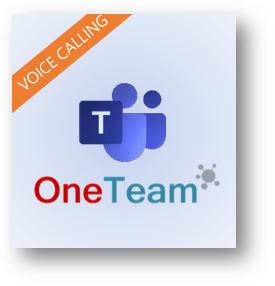 Information Services will make placing and receiving calls using Microsoft Teams, instead of desk phones, available to caregivers in Shared Services departments. To inform this process, these caregivers, including IS, received a survey about how they use their desk phones. Based upon our survey responses, the transition to Teams calling will take place between now and June 2020. Your timely response to the survey allows this transition to move forward, with the data necessary to determine the option right for you.
Information Services will make placing and receiving calls using Microsoft Teams, instead of desk phones, available to caregivers in Shared Services departments. To inform this process, these caregivers, including IS, received a survey about how they use their desk phones. Based upon our survey responses, the transition to Teams calling will take place between now and June 2020. Your timely response to the survey allows this transition to move forward, with the data necessary to determine the option right for you.
Caregivers in other areas, such as our hospitals and clinics, are currently out of scope for Teams calling replacing desk phones.
Using peer-to-peer calling in Teams extends beyond our organization. You can use the feature to call companies or individuals outside of the organization if they also use Teams. Caregivers with a business need to call companies or individuals without Teams can still do so with a direct inward dial (DID) assignment. You can make this request when completing the Teams calling survey.
If you are a Shared Services caregiver who frequently uses your desk phone to engage with frontline caregivers in our hospitals and clinics, please indicate on your survey that you may need a DID assignment. If you already completed your survey and possibly responded incorrectly about a DID assignment, please email PSJHISOneTeam@providence.org.
Why are we moving away from desk phones and dedicated extensions?
In this digital era of apps-based communication, transitioning to Teams calling will help save on the cost of maintaining phones and extensions. Microsoft Teams is designed to serve as a consolidated communications tool, handling chat/instant messaging, meetings and content sharing, and calling through the Teams app on your PC or personal device.
How will IS use the survey about my phone use?
The individual survey responses will result in one of three outcomes:
- Caregivers who never or rarely use their desk phone or extension will no longer have an assigned physical phone. Any previously assigned number will be deactivated and the physical phone will be collected by IS at a later time.
- Caregivers who have a need to call externally can have a new direct inward dial (DID) number assigned through Teams. Any previously assigned number will be deactivated and the physical phone will be collected by IS at a later time.
- Caregivers who have a widely published phone number will be reviewed for eligibility to have their number ported to Teams. Any previously assigned number will be retained. The physical phone will be collected by IS at a later time.
Caregivers who have a business justification for keeping a traditional desk phone (i.e. shared phone lines, call center functionality) may be approved as an exception to retain a physical desk phone.
How soon might this change come?
TEO is evaluating responses received from the survey. The team will reach out to share the recommended approach based on the needs and preferences you shared. Any change to the calling arrangements of Shared Services caregivers will happen between now and June 2020. IS is piloting this first, with our caregivers transitioning by the end of this month. See the detailed timeline.
You will receive notification of your inclusion in a Teams calling rollout approximately seven days prior. You will also receive follow up reminders approximately three days before implementation, and again one day before.
How different is Teams calling from placing and receiving calls on my desk phone?
If calling from Teams on your PC, the experience for calling another PSJH caregiver may already be familiar to you if you’ve placed a voice call from Teams or similar applications such as Skype/Lync.
- Outside calling: For those who need to call contacts who are outside of the Teams application, a DID will be assigned based on survey response. Caregivers with a DID will have access to a keypad for dialing externally and may also add those numbers as contacts within Teams.
- You may need a new headset: If you don’t want to use your PC/laptop speakers and microphone, similar to online meetings or calls today, you may want to order a headset. If your current headset is designed for use with your traditional phone, you may need to purchase a Teams-compatible headset via the IS Self Service Portal.
- Accepting incoming calls: You will see incoming calls that you can accept or reject on your screen. You will also be able to create voicemail greetings and establish forwarding to other numbers if you prefer, such as your cell phone.
- Calling from the Teams mobile app: If you’re using the Teams application on your mobile device, you can make and receive toll-free calls from within the app in a way that is integrated with the conversations and collaborations you might already have going on in Teams. For those of you who may have used apps such as WhatsApp or Skype to make voice calls, the experience is very similar.
- Unwanted calls: DID phone numbers are accessible from outside our network and therefore at risk of receiving spam calls. Caregivers who opt in for peer-to-peer calling without DID will not experience spam calls. Caregivers with DID can choose to block incoming calls with no caller ID or block specific numbers.
More information
See the Teams Calling page and the Teams calling FAQ on the OneTeam Learning Portal.
For other questions or more information, email PSJHISOneTeam@providence.org.
